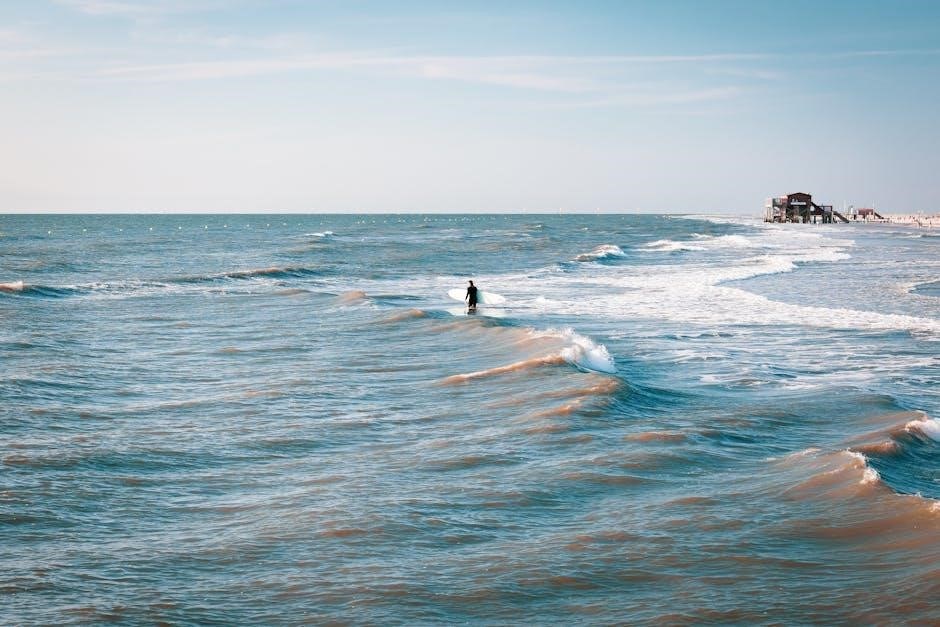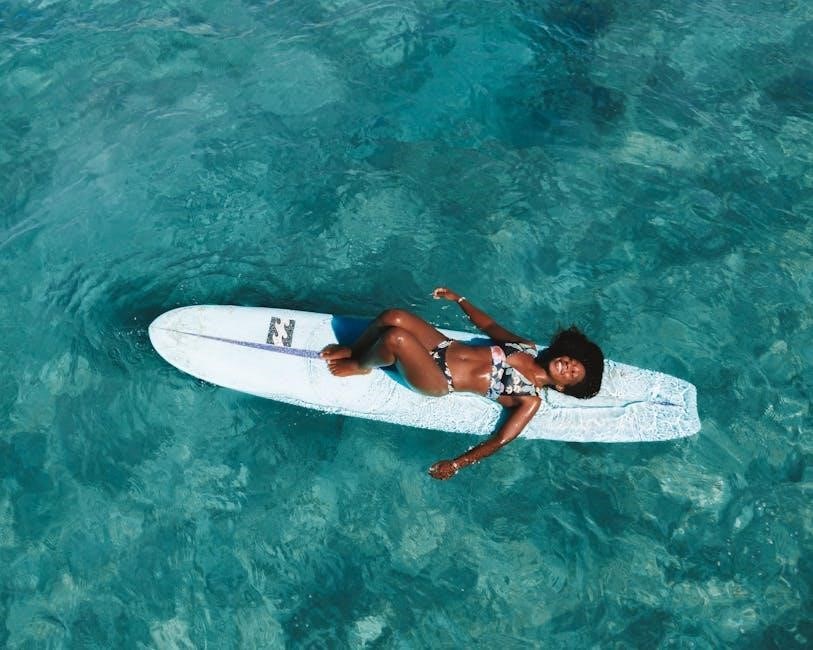Understanding surfboard dimensions is crucial for optimizing performance, stability, and buoyancy․ This guide helps surfers of all levels choose the right board for their skill and wave conditions․
Why Surfboard Dimensions Matter
Surfboard dimensions significantly impact performance, stability, and maneuverability․ Proper length, width, and thickness ensure optimal buoyancy and control, catering to different skill levels and wave conditions․ Understanding these measurements helps surfers select a board that enhances their experience, whether prioritizing speed, ease of use, or versatility in the water․

Key Dimensions of a Surfboard
Key dimensions of a surfboard include length, width, thickness, and volume, each influencing performance, stability, buoyancy, and the overall surfing experience․
Length and Its Impact on Performance
Surfboard length significantly impacts performance․ Longer boards (7-14ft) offer stability and buoyancy, ideal for beginners catching waves․ Shorter boards (<7ft) provide agility but require more skill․ Optimal length balances stability and maneuverability, depending on skill level and wave conditions․
Width and Stability
Surfboard width plays a key role in stability․ Wider boards offer greater buoyancy and balance, making them ideal for beginners․ Narrower boards, while less stable, allow for faster turns and better maneuverability․ The optimal width balances stability and performance, ensuring the board suits the surfer’s height, weight, and skill level, providing better control and overall surfing experience․
Thickness and Buoyancy
Surfboard thickness directly impacts buoyancy․ Thicker boards provide more floatation, making them easier to catch waves and stay afloat․ They are ideal for beginners or those needing extra support․ Thinner boards, while less buoyant, deliver better performance and responsiveness, preferred by advanced surfers; Balancing thickness with other dimensions ensures the board meets the surfer’s needs for both stability and maneuverability, enhancing the overall surfing experience and performance․
Volume and Its Role
Volume measures a surfboard’s displacement in water, calculated by length, width, and thickness․ Higher volume boards offer greater buoyancy, making it easier to catch waves and stay afloat, ideal for beginners․ Lower volume boards provide better maneuverability, suited for advanced surfers in larger waves․ The right volume depends on surfer weight, skill level, and style, ensuring optimal performance and balance in the water․ Proper volume selection enhances the overall surfing experience․

Surfboard Shapes and Their Dimensions
Surfboard shapes vary to suit different styles, from shortboards for agility to longboards for stability․ Each shape has unique dimensions, influencing performance and rider experience in the water․
Shortboards: Dimensions for Experienced Surfers
Shortboards, ideal for skilled surfers, typically range from 5’8″ to 7′ in length, with widths between 18″ to 22″․ Their slim profiles enhance agility and speed, allowing precise control in tight turns․ Thicker shortboards (2․5″–3″) improve buoyancy, while thinner ones (2″–2․4″) offer responsiveness․ Experienced riders favor these dimensions for high-performance surfing, enabling quick maneuvers and adaptability in various wave conditions․ Fiberglass or carbon fiber constructions are common, ensuring durability and optimal responsiveness․
Longboards: Classic Dimensions for Cruising
Longboards, designed for smooth cruising, typically range from 8′ to 14′ in length, with widths of 20″ to 24″ and thicknesses of 2․5″ to 4″․ Their rounded noses and squared or rounded tails provide stability and maneuverability․ These dimensions suit both traditional surfing and modern styles, offering a forgiving ride and timeless appeal․ Longboards are ideal for carving and gliding, making them a favorite among experienced surfers seeking a classic, laid-back experience in various wave conditions․
Funboards: A Balance Between Stability and Maneuverability
Funboards, typically measuring 7′ to 9′ in length, 20″ to 23″ in width, and 2․5″ to 3․5″ in thickness, offer a perfect blend of stability and agility․ Their rounded noses and squared or rounded tails enhance maneuverability․ Ideal for intermediate surfers, funboards provide buoyancy and control, making them versatile for various wave conditions․ They are a great transition board, balancing ease of catching waves with the ability to perform turns, fostering progression in skill development․
Softboards: Safe Dimensions for Beginners
Softboards, designed for safety and ease, typically range from 7′ to 8′ in length, 22″ in width, and 3″ in thickness․ Their foam construction ensures soft edges, reducing injury risk․ These boards provide excellent buoyancy and stability, making them ideal for beginners․ The rounded nose and squared tail enhance forgiveness during maneuvers․ Durable and lightweight, softboards are perfect for learning basic surfing skills, offering a forgiving platform to catch waves and build confidence in the water․

Materials and Their Influence on Dimensions
Surfboard materials like foam, fiberglass, and carbon fiber significantly impact dimensions, affecting performance, durability, and weight․ Each material offers unique benefits, shaping the board’s size and usability for specific surfing styles․
Foam Surfboards: Durable and Forgiving
Foam surfboards are known for their durability and forgiveness, making them ideal for beginners and surf schools․ Constructed from foam blanks and laminated with fiberglass or resin, these boards are lightweight and resistant to dings․ Their forgiving nature allows for softer landings, reducing the risk of injury․ Foam surfboards often feature rounded noses and squared tails, enhancing stability and buoyancy․ Their thicker profiles make them easier to balance on, while their lightweight design ensures effortless paddling․ They are also low maintenance and environmentally friendly, as foam is recyclable and less harmful than traditional materials․
Fiberglass and Carbon Fiber Surfboards: Performance-Oriented
Fiberglass and carbon fiber surfboards are built for high performance, offering exceptional strength and durability․ Fiberglass boards are lightweight with a responsive flex, ideal for intermediate to advanced surfers․ Carbon fiber adds stiffness, enhancing speed and maneuverability․ These boards are dimensioned for precision, with narrower widths and rounded pin tails for tighter turns․ Their construction ensures minimal water absorption, maintaining buoyancy and speed․ They are a top choice for surfers seeking a balance of durability and elite performance in various wave conditions․
Choosing the Right Dimensions for Your Skill Level
Choosing the right surfboard dimensions is essential for optimal performance and confidence․ Factors like skill level, height, weight, and wave conditions determine the ideal size and volume for your board․
Beginner-Friendly Dimensions
Softboards are ideal for beginners due to their soft foam construction, which is safer and more forgiving․ Dimensions typically range from 7 to 9 feet in length, 20 to 24 inches in width, and 2․5 to 3․5 inches in thickness․ These dimensions provide excellent stability and buoyancy, making it easier to catch and stay on waves․ The higher volume of these boards helps beginners maintain balance and confidence while learning to surf․
Intermediate Surfers: Balancing Volume and Maneuverability
Intermediate surfers benefit from boards with balanced volume and responsiveness․ Dimensions like 6’6″ to 7’6″ in length, 20-22″ in width, and 2․3-2․7″ in thickness provide stability while allowing for tighter turns․ Lower volume than beginner boards enhances maneuverability, while maintaining enough buoyancy to catch waves easily․ Funboards or performance softboards are ideal, offering a mix of forgiveness and precision to refine skills and progress in various wave conditions․
Advanced Surfers: High-Performance Dimensions
Advanced surfers prioritize high-performance dimensions for precision and speed․ Boards typically range from 5’8″ to 6’4″ in length, with widths around 18-20″ and thicknesses of 2-2․5″․ These dimensions reduce volume, enhancing sensitivity and maneuverability․ Shortboards or performance-oriented shapes are ideal, allowing sharp turns and control in critical wave sections․ Lower volume demands greater skill but delivers unmatched responsiveness for experienced riders seeking peak performance in challenging conditions;
Wave Conditions and Surfboard Dimensions
Wave conditions greatly influence surfboard dimensions․ Smaller waves require more volume and stability, while larger waves demand speed and maneuverability, shaping the ideal board size and shape․
Small Wave Dimensions
Small wave dimensions prioritize volume and stability to maintain momentum in weaker conditions․ Boards typically range from 7–9 feet in length and 21–23 inches in width, ensuring buoyancy․ A thickness of 2․5–3 inches enhances floatation, making it easier to catch and ride smaller waves․ Funboards and softboards are ideal for these dimensions, providing forgiveness and ease of maneuverability in less powerful surf, perfect for beginners or casual cruising․
Large Wave Dimensions
Large wave dimensions emphasize performance and control in powerful surf․ Boards are shorter, typically 5․5–7 feet, with a narrower width (18–20 inches) and thinner profile (2–2․5 inches) for precision․ These dimensions enhance maneuverability and speed, allowing surfers to handle steep drops and tight turns․ High-performance materials like fiberglass or carbon fiber are often used, ensuring durability and responsiveness in heavy conditions, making them ideal for advanced surfers seeking thrills in big wave environments․

Common Mistakes in Selecting Surfboard Dimensions
A common error is prioritizing style over functionality; Many surfers overlook their skill level, choosing boards too advanced or too basic․ Ignoring volume and focusing solely on length or width can lead to poor performance․ Additionally, not considering wave conditions often results in mismatched boards․ Lastly, neglecting personal height and weight can affect buoyancy and control, making it harder to catch and ride waves effectively․

Customizing Your Surfboard
Customizing involves tailoring dimensions to your height, weight, and surfing style for optimal performance․ This ensures the board fits your needs, enhancing both control and comfort․
Considering Height, Weight, and Surfing Style
When customizing a surfboard, height, weight, and surfing style are critical factors․ Taller surfers may prefer longer boards for stability, while lighter individuals might opt for thinner designs․ Surfing style also plays a role; aggressive maneuvers require responsive dimensions, whereas cruisers may prioritize stability․ Balancing these elements ensures the board performs optimally for the rider, enhancing both control and comfort in the water․

Popular Surfboard Brands and Their Offerings
Top surfboard brands like Quiver, Channel Islands, and Firewire offer high-performance designs tailored to specific surfing styles․ Lost Surfboards is known for its versatile models, while BIC Sport and Softlite cater to beginners with durable, user-friendly boards․ These brands provide a range of options, ensuring surfers can find a board that matches their skill level, wave preferences, and personal style, making the surfing experience more enjoyable and efficient for all riders․

Safety Considerations
Softboards are ideal for beginners due to their foam construction, reducing injury risk․ Leashes keep boards attached, preventing loose boards from causing accidents in the water․
Softboards and Safety
Softboards are designed with safety in mind, featuring foam construction that minimizes injuries․ Their soft surfaces reduce the risk of cuts and bruises, making them perfect for beginners․ Additionally, softboards often come with rounded noses, which are less likely to cause harm in the event of a collision․ This focus on safety allows new surfers to build confidence in the water without the risks associated with harder materials․ Their durability also ensures long-lasting performance, even with frequent use․ By prioritizing safety and comfort, softboards create a welcoming experience for those learning to surf․ This approach helps prevent accidents and fosters a positive environment for skill development․ The use of softboards is highly recommended for schools and training programs due to their forgiving nature and ability to protect users from minor impacts․ Overall, softboards are an excellent choice for anyone prioritizing safety while enjoying the sport․ The combination of soft materials and thoughtful design makes them ideal for learners and casual surfers alike․
Leashes and Fins: Essential Safety Features
A leash ensures your surfboard stays attached, preventing it from drifting away or causing collisions․ Properly fitted leashes keep you connected, enhancing control and safety․ Fins provide stability and maneuverability, crucial for maintaining balance․ Their size and shape impact performance, while their material ensures durability․ Together, leashes and fins are vital for secure, enjoyable surfing experiences, protecting both the surfer and others in the water․ These features are indispensable for safe and effective surfing practices․

Environmental Impact of Surfboard Manufacturing
Surfboard manufacturing impacts the environment due to non-biodegradable materials․ However, eco-friendly options like recycled foam and sustainable practices are reducing the industry’s ecological footprint․
Eco-Friendly Materials and Sustainable Practices
Eco-friendly materials like recycled foam, bamboo, and plant-based resins are transforming surfboard manufacturing․ Sustainable practices, such as minimizing waste and using energy-efficient processes, reduce environmental impact․ Many brands now prioritize these methods, offering boards that perform well while promoting ocean conservation․ By choosing sustainable options, surfers can enjoy their sport with a clearer conscience, supporting both performance and the planet’s well-being․
Selecting the right surfboard dimensions involves balancing size, shape, and material to suit your skill level and wave conditions․ By understanding length, width, thickness, and volume, you can enhance performance and enjoyment․ Whether you’re a beginner or an advanced surfer, choosing a board tailored to your needs ensures a better surfing experience․ Always consider eco-friendly options to support sustainability while riding the waves․